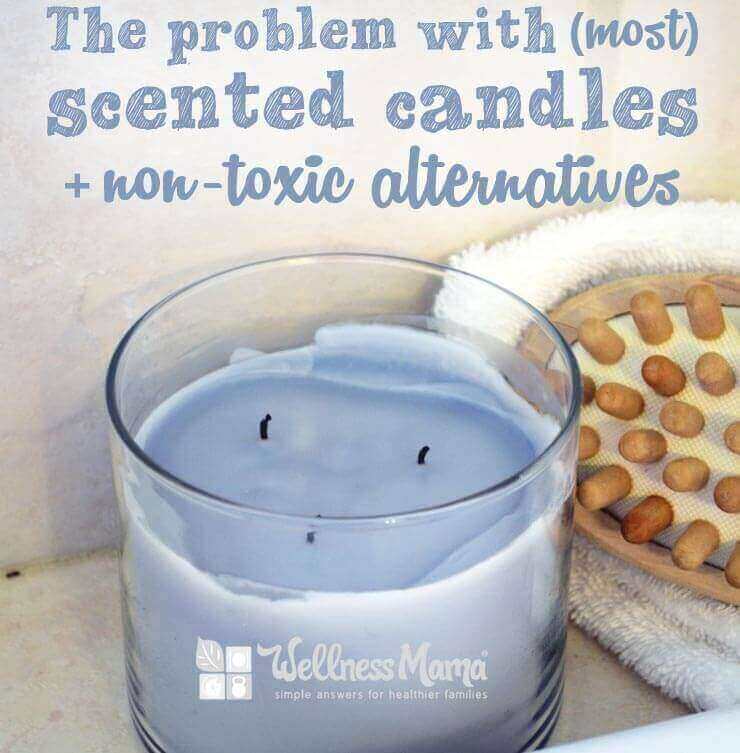I’ll admit- sometimes, I wish I could climb back into my years of ignorance is bliss and forget everything I’ve learned about real food and natural living. It would be so easy to go back to before I knew about the problems with vegetable oils, or sugar, or processed grains.
It would be so easy to feed my kids cereal out of a bag and use regular laundry detergent. But I can’t.
One of the areas I most wish this about is scented candles. Even innocent looking scented candles with their soft warm glow have their dirty secrets. Ready to throw your hands up in despair that everything is toxic?
Hear me out:
How are Scented Candles Made?
Though they seem safe, regular scented candles are a huge source of indoor air pollution and they put off chemicals that are considered just as dangerous as second-hand smoke. Paraffin is a petroleum waste product and has to be deodorized and chemically bleached before it can be made in to wax. (source)
Most candles are made of paraffin wax, which creates highly toxic benzene and toluene when burned (both are known carcinogens). In fact, the toxins released from paraffin candles are the same as those found in diesel fuel fumes.
On top of that, many scented candles also have wicks that contain heavy metals like lead, and even a few hours of burning them can create levels of airborne heavy metals that are much higher than the acceptable limits. In the US, candle wicks are supposed to be made of cotton or paper, but studies have found that as much as 30% of candles contain heavy metals in the wicks.
“A candle with a lead-core wick releases five times the amount of lead considered hazardous for children and exceeds EPA pollution standards for outdoor air, says the CPSC, which is why they banned lead wicks in 2003. Exposure to high amounts of lead has been linked to hormone disruption, behavioral problems, learning disabilities, and numerous health problems.” (source)
Many candles also contain artificial scents and dyes, which release additional chemicals when burned. (source)
“Other toxic chemicals that may be present in the paraffin mixture and released through burning include: Acetone, Trichlorofluoromethane, Carbon Disulfide, 2-Butanone, Trichloroethane, Trichloroethene, Carbon Tetrachloride, Tetrachloroethene, Chlorobenzene, Ethylbenzene, Styrene, Xylene, Phenol, Cresol, Cyclopentene. Some of the toxins are found in other products such as paint, laquer and varnish removers– that’s potent and powerful stuff!” (from Keeper of the Home)
Additionally:
“Petro-soot from paraffin candles gives off the same soot as the exhaust of a diesel engine, and is considered just as dangerous as second hand smoke, causing problems from headaches to lung cancer. Paraffin fumes have been found to cause tumors in the kidneys and liver of lab animals.” (source)
When I first realized all the problems with scented (and unscented paraffin based candles) candles, I was really disappointed. Thankfully, I found some great alternatives…
Alternatives to Scented Candles
Fortunately, there are some great alternatives to scented candles and after trying them, I realize I like the alternatives more.
One alternative is soy-based candles, but the majority of soy is genetically modified, and I prefer to not use soy at all. The best alternative I’ve found is beeswax candles, which are not only safe, but have the added benefit of helping clean indoor air.
I’ve talked about how we use them to help purify indoor air, and beeswax candles give off the warm glow of candles without the toxic effects.
Beeswax candles emit negative ions, which help reduce positively charged ions in the air. From the dictionary:
“Positive ions, or cations, are formed by the loss of electrons; negative ions, or anions, are formed by the gain of electrons. An atom that has either lost or gained one or more electrons, so that it has an electrical charge. Ions can be either positively or negatively charged.”
Positive ions are generated by electrical devices, by scented candles, by walking across carpet, and even by heating/cooling systems. They are a fact of life, but they can carry everything from dust to pollen to toxic mold, so it is important to reduce them. Indoor air typically has a higher concentration of positive ions.
This is where negatively charged ions come in. They bind together and have a heavier molecular weight so they are no longer floating around the air.
Beeswax candles are a source of negative ions, and can help reduce indoor air pollution. (Here are some other ways to improve indoor air quality)
What we Use
I threw out all of our scented candles and now just keep on hand:
- A case of votive beeswax candles
- 9-hour burn beeswax candles for power outages (we had one tonight)
- A case of tea lights for candle holders
I also found beeswax birthday candles to use in place of conventional birthday candles. (We sometimes put candles in our banana nut muffins at birthday breakfasts)
The one thing I did miss about scented candles was the scent, so I also started diffusing essential oils to freshen indoor air. My favorite oils to diffuse are peppermint, citrus and lavender.
Detoxing our indoor air
After I discovered the problems with scented candles, I also wanted to find out what I could do to reduce/remove the pollutants I had already released in to our home. I found out about beeswax candles (which I had already used to replace our scented candles), salt lamps and indoor plants.
I started using these methods to detox our indoor air. We now have salt lamps and indoor plants in most rooms and when I need/want to burn candles, I use beeswax.
I wish sometimes that I could use conventional scented candles, but am happy to be able to provide a healthier alternative to my family with beeswax candles and essential oils for scent.
Do you use scented candles? Ever considered the alternatives? Tell me below!


Leave a Reply